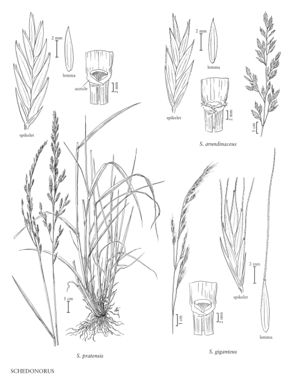Difference between revisions of "Schedonorus giganteus"
imported>Volume Importer |
imported>Volume Importer |
||
| Line 47: | Line 47: | ||
|publication year= | |publication year= | ||
|special status= | |special status= | ||
| − | |source xml=https://bitbucket.org/aafc-mbb/fna-data-curation/src/ | + | |source xml=https://bitbucket.org/aafc-mbb/fna-data-curation/src/200273ad09963decb8fc72550212de541d86569d/coarse_grained_fna_xml/V24/V24_635.xml |
|subfamily=Poaceae subfam. Pooideae | |subfamily=Poaceae subfam. Pooideae | ||
|tribe=Poaceae tribe Poeae | |tribe=Poaceae tribe Poeae | ||
Latest revision as of 16:24, 11 May 2021
Plants perennial. Culms to 1.5 m. Leaves convolute in young shoots; auricles glabrous; ligules 0.5-2.5 mm; blades (10)20-40 cm long, 4-18 mm wide. Panicles 8-50 cm; branches usually 2 per node. Spikelets 8-13(20) mm long, 1.5-2.5 mm wide, with 3-10 florets. Lower glumes 4-7 mm; upper glumes 5-8 mm; lemmas 6-9 mm, usually scabrous or hispidulous, rarely smooth, awns 10-18 mm; paleas as long as to slightly longer than the lemmas; anthers 2.5-3 mm. Caryopses 3-4.6 mm long, 1-1.5 mm wide. 2n = 42.
Distribution
Ont., Que., N.Y., Mich., Conn.
Discussion
Schedonorus giganteus is adventive from Europe. It is cultivated as an ornamental, and has escaped to woodland openings and edges and to shaded ravines, at isolated localities in Quebec, Ontario, Michigan, New York, and Connecticut.
Selected References
None.
